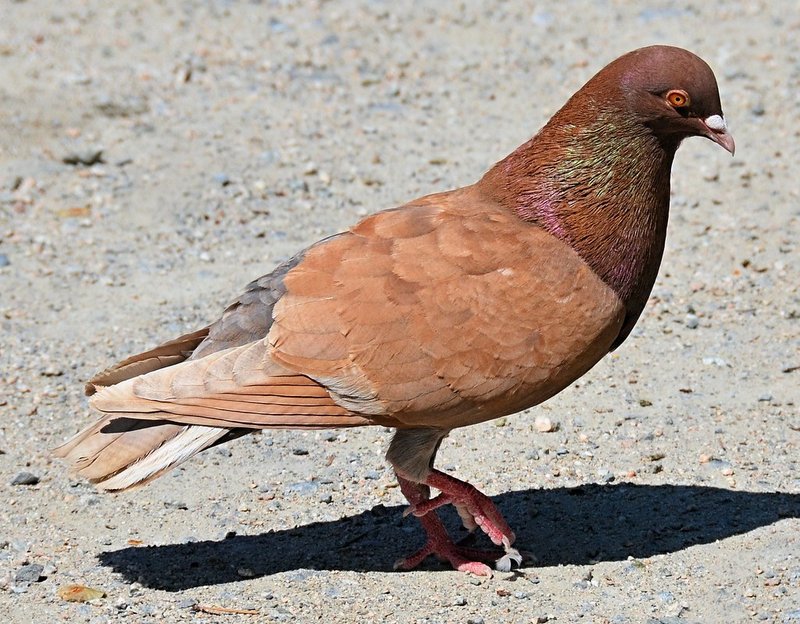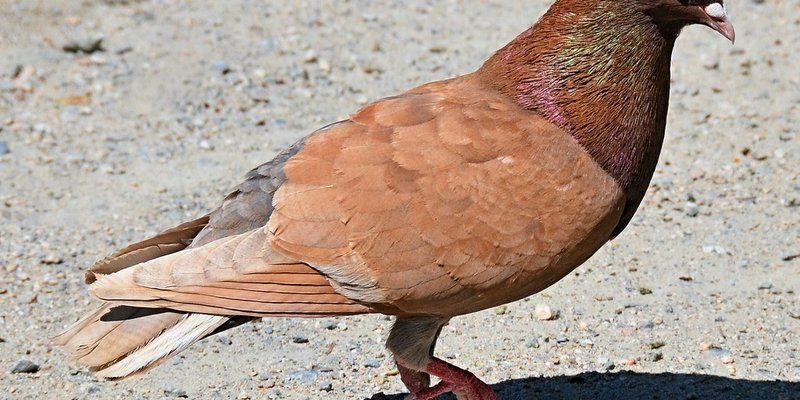
If you’ve walked through a park or a busy city street, you’ve likely spotted a Rock Pigeon. These birds are often seen strutting around with an air of confidence and a hint of curiosity. They’re the friendly neighborhood birds that seem to know exactly where to find the best crumbs. But there’s much more to these birds than meets the eye. Known scientifically as Columba livia, Rock Pigeons are fascinating creatures with rich histories and surprising behaviors. Let’s dive deeper into what makes them so special.
Imagine walking into a bustling square in a city—there’s a mix of sights and sounds: people chatting, street vendors calling out, and, of course, the gentle cooing of pigeons as they bob around looking for food. These birds have found a way to thrive in urban environments, adapting to life alongside humans. In fact, Rock Pigeons have a long-standing relationship with us, dating back thousands of years! Whether you see them perched on statues or darting to snatch a dropped piece of bread, they add a unique charm to our surroundings.
Physical Characteristics
Rock Pigeons come in various colors and patterns, but they typically showcase shades of gray with iridescent feathers on their necks. Their bodies are robust and streamlined, which allows them to fly gracefully. Adults generally measure about 12-14 inches in length with a wingspan that can reach about 25-28 inches. The average weight of a Rock Pigeon ranges from 9 to 13 ounces, giving them a sturdy appearance.
What’s really eye-catching is their unique coloration. While many might assume all Rock Pigeons look alike, you can actually spot ones with brown, black, and even white plumage. This variety is due to selective breeding and natural variations. Their beaks are short and stout, perfect for cracking seeds, which is their primary food source. And let’s not forget their bright red eyes, which can be quite striking!
Habitat and Distribution
Rock Pigeons are incredibly adaptable birds. You can find them almost anywhere in the world, except for extreme climates like very high mountains or the farthest reaches of the polar regions. They thrive in urban areas, but they also inhabit agricultural lands and cliffs in their natural state. This incredible adaptability is one of the reasons they’ve become so widespread.
When it comes to nesting, Rock Pigeons prefer ledges and cliffs, often settling on buildings, bridges, and even inside barns. They’re not picky about where they make their homes, as long as they have a safe spot to lay their eggs. You might even find them nesting in unexpected places like door frames or window sills. It’s fascinating to think about how these birds have integrated themselves into our everyday lives!
Diet and Feeding Habits
Rock Pigeons are primarily granivorous, meaning their diet mainly consists of seeds. They love to munch on grains such as corn, wheat, and millet. However, they’re opportunistic feeders, so they’ll also eat fruits, vegetables, and even discarded food they find while foraging. If you’ve ever thrown a handful of birdseed, you know how quickly they can gather in flocks. Their ability to adapt their diet based on availability is one of their survival strategies.
One interesting fact about their feeding habits is that they possess an excellent memory that helps them locate food sources over time. Rock Pigeons can remember specific locations and even recognize individual humans. So, if you’ve ever fed a pigeon and it returned later, it probably remembered you! This intelligence extends to their ability to differentiate between various food items, allowing them to be selective about what they eat.
Behavior and Social Structure
When it comes to behavior, Rock Pigeons are social creatures that thrive in flocks. They often gather in groups, which helps them find food and can provide safety in numbers. Their social structure is quite interesting; they often form strong pair bonds, and both partners share parenting duties. After mating, they build their nests together and take turns caring for their young.
You might notice their characteristic cooing sounds, which play a role in communication. These vocalizations are a way for them to express excitement, stress, or even affection towards each other. Watching them interact can be a delightful experience. Whether they are puffing up their chests to impress a mate or engaging in playful chases with each other, their antics can be quite entertaining!
Reproduction and Lifespan
Rock Pigeon mating season generally peaks in spring, but they can breed year-round in favorable conditions. Their courtship involves some fascinating displays of affection, from bowing and head-bobbing to puffing out their chests. Once the pair decides to mate, they’ll build a nest together, often using twigs, leaves, and other found materials to create a cozy home for their future chicks.
After laying 1 to 3 eggs, the parents take turns incubating them for about 18 days. Once the chicks hatch, they are cared for diligently by both parents. Interestingly, Rock Pigeons produce a substance known as “pigeon’s milk,” a nutrient-rich fluid that they feed to their young. This special feeding method aids the chicks in growing and developing quickly.
Interesting Facts
| Common Name: | Rock Pigeon |
| Scientific Name: | Columba livia |
| Average Size: | 12-14 inches |
| Wingspan: | 25-28 inches |
| Weight: | 9-13 ounces |
| Average Lifespan: | 3-5 years in the wild, up to 15 years in captivity |
| Diet: | Seeds, grains, fruits, and scraps |
Conservation Status
Despite their abundance, Rock Pigeons do face threats in certain areas. Habitat loss due to urban development can limit their nesting sites, and issues like pollution can affect their health. However, they are classified as a species of “Least Concern” by the International Union for Conservation of Nature (IUCN). This means their populations are generally stable, but it’s still important for us to be aware of their environments and the challenges they face.
Interestingly, Rock Pigeons have been utilized in various ways throughout history, including as message carriers during wartime. Their homing abilities are exceptional, allowing them to navigate back to their homes from long distances. This innate skill has made them invaluable in certain situations, highlighting their importance in human history.
Next time you see a Rock Pigeon, take a moment to appreciate the incredible journey this bird has taken alongside humans. From their fascinating behaviors to their adaptable lifestyles, they truly are remarkable creatures. Whether they’re flitting about in the city or nesting in a secluded spot, these birds remind us of the resilience of nature. So, the next time you’re out and about, you can feel a little bit smarter about the little creature cooing in the park!
FAQ
Why are Rock Pigeons so common in cities?
Rock Pigeons have adapted beautifully to urban environments. They find ample food supplies and nesting spots on buildings, making cities a perfect habitat for them. Their ability to thrive in these settings is a testament to their resilience and adaptability.
How long do Rock Pigeons live?
In the wild, Rock Pigeons typically live around 3 to 5 years. However, in captivity, they can live up to 15 years or more with proper care. Factors such as predation, disease, and environmental conditions play a significant role in their lifespan.
What do Rock Pigeons eat?
Rock Pigeons primarily eat seeds, grains, and fruits. They are opportunistic feeders and will also consume scraps they find in urban areas. This flexibility in their diet helps them thrive in various environments.
Do Rock Pigeons migrate?
Unlike many bird species, Rock Pigeons are generally non-migratory. They tend to remain in their established territories year-round. However, some populations may move short distances in search of food or suitable nesting sites.
How can you tell a male Rock Pigeon from a female?
While it’s challenging to tell them apart just by looking, male Rock Pigeons tend to be slightly larger and may exhibit more vibrant coloration, especially during courtship displays. Males are more likely to engage in puffing and bowing to attract females.
Are Rock Pigeons social birds?
Yes! Rock Pigeons are highly social animals; they usually live in flocks. Their social structure includes forming strong pair bonds, and they enjoy the company of others, which can enhance their foraging success and provide safety from predators.
Can Rock Pigeons return home over long distances?
Absolutely! Rock Pigeons are famous for their homing abilities. They can find their way back to their nests from astonishing distances, which is why they have been used as messenger birds throughout history.
What sounds do Rock Pigeons make?
Rock Pigeons are known for their gentle cooing sounds. These vocalizations are an essential part of their communication, used to express various emotions—everything from excitement to mating calls!
Are Rock Pigeons harmful to humans?
Generally, Rock Pigeons are not harmful to humans. However, like many birds, they can carry a few diseases. It’s always good practice to wash your hands after handling bird feed or being around them to minimize any health risks.
Can you keep Rock Pigeons as pets?
Yes, many people keep Rock Pigeons as pets! They can be affectionate and social when raised in a loving environment. They require care, feeding, and space to fly. If you’re considering adopting one, make sure to understand their needs for a happy, healthy life.
How can I help Rock Pigeons in my area?
Creating a bird-friendly environment can significantly benefit Rock Pigeons and other birds. Keeping your area clean, providing food sources, and maintaining safe nesting sites can help them thrive. Observing and appreciating their presence in your neighborhood is also a fantastic way to support them!

